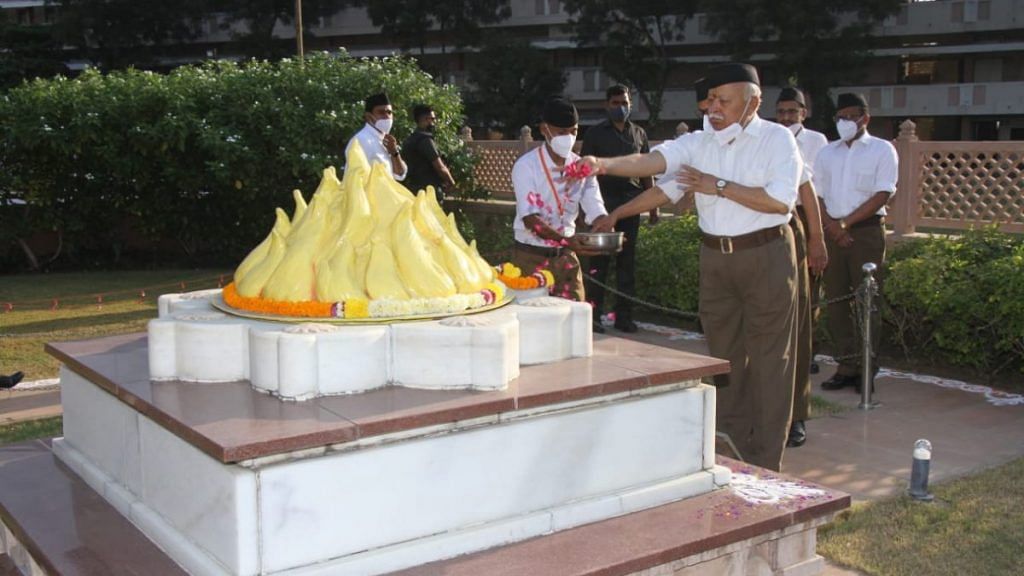New Delhi: Why did Mohan Bhagwat, the Rashtriya Swayamsevak Sangh (RSS) sarsanghchalak or patron, have to dig up a six-year-old document for his Vijayadashami speech Friday? It was the resolution that the Akhil Bharatiya Karyakari Mandal or the RSS’ All-India Executive Committee had passed in Ranchi way back in 2015.
For one, Bhagwat needed the document — little-known outside the hallowed Sangh circles — to set a new agenda for the RSS and its ideological protégé, the ruling Bharatiya Janata Party (BJP): Formulation of a new population policy to address ‘demographic imbalance’, given the ‘rising’ ratio of Muslims in India’s population.
The RSS, “a movement for national reconstruction”, was looking for a new rallying point for the people after the near-fulfilment of its three original agendas — abrogation of Article 370, construction of Ram temple in Ayodhya and implementation of uniform civil code (UCC).
The first two were fulfilled in 2019 while Sangh leaders are no longer very keen on pushing the third after the enactment of the Triple Talaq legislation; the apprehension is the UCC may alienate even a section of Hindus who follow customary practices.
A new population policy is now right on top of the Sangh’s agenda, say its functionaries.
The ABKM resolution gave a few data points to back Bhagwat’s demand for a new population policy — ratio of Muslims going up to 14.23 per cent in the 2011 census from the 9.8 per cent in 1951.
A press statement by the Ministry of Home Affairs, as reported by the Mint in August 2015, suggested that Islam was the fastest growing religion in India.
“The proportion of Hindu population to total population in 2011 has declined by 0.7 percentage points (PP)…of Sikh…by 0.2 PP and the Buddhist …by 0.1 PP during 2001-2011. The proportion of Muslim population to total population has increased by 0.8 PP,” said the MHA statement.
What the ABKM document and the MHA statement seemed to have overlooked in the 2011 census was the fact that between two decades — 1991-2001 and 2001-2011 — Hindu population growth rate decreased from 19.92 to 16.76 per cent while Muslim declined from 29.52 to 24.60 per cent, the sharpest fall in the past six decades.
According to a study by the US-based Pew Research Centre, gaps in fertility rates between two largest religious groups were shrinking. Muslim women had an average of 1.1 more children than Hindu women in 1992, but the gap shrank to 0.5 by 2015, said the report.
Data points apart, the bogey of Muslims outnumbering Hindus, first flagged by Hindutva ideologue V.D. Savarkar, is likely to get fresh traction after Bhagwat’s reference to “demographic imbalance” in terms of an increase in Muslim population ratio. It is also likely to resonate in the run-up to the next round of assembly elections, with Uttar Pradesh Chief Minister Yogi Adityanath promising to bring in a population control law “at the right time”, and the BJP government in Uttarakhand ordering a survey to identify areas witnessing a spurt in Muslim population.
Also read: ‘Vast differences’ in growth rate of religions — Bhagwat calls for NRC, new population policy
RSS chief’s formulation likely to act as govt’s guiding force
The RSS chief’s formulation of the new population policy is also likely to act as a guiding force for the Modi government.
Prime Minister Narendra Modi had broached the subject of population control in his Independence Day speech in 2019 but he left it at that. The RSS chief has now provided him a reason to follow up his words with action.
By digging up a 2015 document, Bhagwat has also sought to mollify a section of his Sangh colleagues and Right-wing supporters who were uneasy about his repeated assertions about the Hindus and the Muslims having the same DNA, who couldn’t be differentiated on the basis of how and who they worship.
Although the RSS chief spoke in a similar vein again Friday, he left enough to please his Hindutva acolytes in the written text of his speech uploaded on the RSS website.
It contained the 2015 resolution, which spoke about the decreasing population ratio of “religions of Bharatiya origins” such as Hinduism, Buddhism, Jainism and Sikhism (as against those with foreign origin such as Islam, Christianity and Judaism).
This distinction is very much modelled on Savarkar’s to define Hinduness. Apart from other criteria, his idea of a Hindu was someone who must consider India not just as his motherland or fatherland — mathrubhumi or pitribhumi — but also as punyabhumi or Holy Land.
The latter criterion excludes Muslims, Christians and Jews from the wider gambit of Hindutva. Therefore while Bhagwat’s DNA theory sounds like a very inclusive philosophy, the re-iteration of the concept of Bharatiya-origin religions in the 2015 resolution referred by Bhagwat is meant to negate any revision of Hindutva as originally envisioned.
Bhagwat also used the six-year-old document to revive the subject of the national register of citizens (NRC) and rake up alleged conversions into Christianity and illegal infiltration of Muslims from Bangladesh. These points are likely to dictate the political discourse — for the BJP, at least — in coming weeks and months.
(Edited by Arun Prashanth)
Also read: Why PM Modi picked politicians with criminal charges to assist Amit Shah in home ministry
